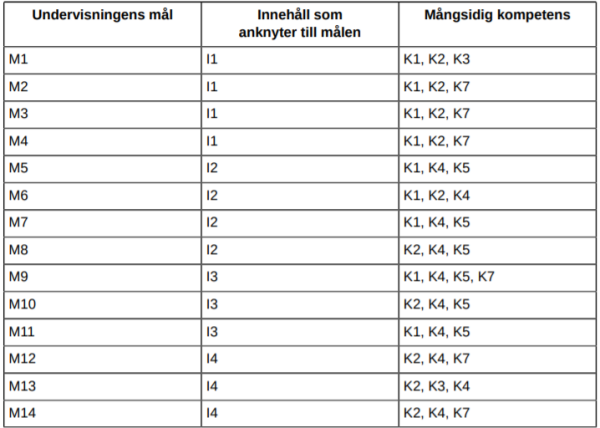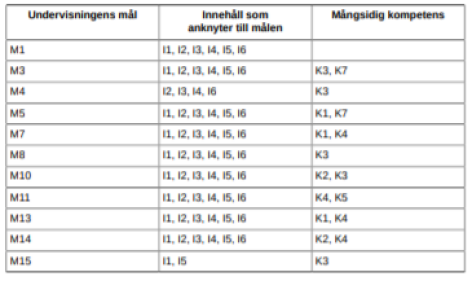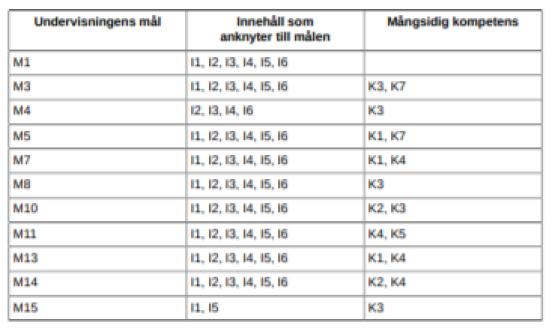 References to Vörå municipality’s curriculum for grades 1–9 regarding social sustainability:
References to Vörå municipality’s curriculum for grades 1–9 regarding social sustainability:
For each thematic area, there are references from the curriculum of each subject where the theme can be reflected.
First, there are references to the theme of group dynamics in the subjects GY, OL, MO, SL, MU.
Then, there are references to the theme of self-care in GY, OL, RE, MA.
THEME: GROUP DYNAMICS
Group dynamics are included in the core content I2 in physical education for first grade:
- "Physical education includes simple physical games with rules, tasks, and activities where students cooperate and gain experience in helping one another."
The goals related to I2 in physical education for first grade are:
- M7 guide the student to regulate their actions and emotional expressions in social situations in physical education
- M8 support cooperative skills, such as following mutually agreed-upon rules by guiding the student to take responsibility for making shared games and activities successful
K2: "Students should be encouraged and guided to engage in positive interaction and collaboration. Lessons, parties, play, games, meals, and cooperation inside and outside school provide opportunities to practice working together with a diverse range of people."
K3: "At school, students should learn basic facts about promoting their own and collective well-being, safety, and a good everyday life. It's important for them to learn to move independently and safely in their surroundings, use safety and protective equipment, and develop their knowledge and skills as pedestrians and cyclists. They should also practice how to act in various risky situations and how to seek help."
K6: "Schoolwork should provide students with diverse opportunities to learn to work independently and with others. They should practice participating in groups, collaborating, adapting their own ideas to those of others, and taking responsibility according to their age."
K7: "Together with the students, discussions should be held about what justice, equality, and reciprocity mean. Students should familiarize themselves with democratic principles and democracy in practice through their own experiences."
Group Dynamics is part of the central content I2 in Environmental Studies in grade 1.
- "Students practice working together and participating in different groups."
Group Dynamics is part of the central content I6 in Environmental Studies in grade 1.
- "Consideration of the impact of one's actions on oneself, other people, and the immediate environment."
The image below shows the objectives I2 and I6 relate to in the curriculum for Environmental Studies in grade 1.
K1: "Students should practice planning and setting goals for their own work and collaborative projects, as well as evaluating their efforts."
K2: "Students should be encouraged and guided towards positive interaction and collaboration. Lessons, parties, play, games, meals, and teamwork inside and outside school offer opportunities to learn how to work with various people."
K3: "The importance of shared rules, good habits, and encouraging feedback is increasing."
K6: "Schoolwork should offer students diverse opportunities to learn how to work independently and with others. They should practice participating in groups and collaborating, adapting their ideas to others, and taking responsibility according to their age."
K7: "From the first grade, students should be involved in discussing and planning goals for their own work and their group's projects... With students, discuss what justice, equality, and reciprocity mean. Students should, through their own experiences, become familiar with democratic principles and democracy in practice."
Group Dynamics is included in the core content I1 in the mother tongue for grade 1:
- "Students practice verbally expressing and naming their surroundings, listening, asking, answering, and storytelling face-to-face in various communication situations and for different purposes. They practice communicating in a group in different text environments."
Group Dynamics is included in the core content I4 in the mother tongue for grade 1:
- "Students observe the spoken language in its different variations and reflect on how language use affects the surroundings."
The image to the right shows which goals I1 and I4 are connected to in the curriculum for the mother tongue in grade 1.

K1: "Students should practice planning and setting goals for both their own work and collaborative tasks, as well as evaluating the work."
K2: "Students should be encouraged and guided toward positive interaction and cooperation. Lessons, celebrations, play, games, meals, and collaboration both in and outside of school provide opportunities to practice functioning together with a variety of people."
K3: "The importance of shared rules, good habits, and encouraging feedback increases."
K4: "Students should learn to search for information from various sources and to communicate that information to others."
K7: "Together with the students, discuss the meanings of justice, equality, and reciprocity. Students should familiarize themselves with democratic principles and democracy in practice through their own experiences."
Group Dynamics is part of the core content I6 in crafts for first grade:
- "Throughout the crafting process, students are given opportunities for self-assessment and peer assessment. They learn to give feedback to others."
The goals related to I2 in crafts for first grade are:
- M5 support the student in developing their self-esteem by providing opportunities to feel successful, understand, and come up with solutions in crafting
K1: "Students should practice planning and setting goals for their own and collective work, and evaluating the work."
K3: "The importance of common rules, good habits, and encouraging feedback increases."
Group Dynamics are included in the core content I1 in music for Grade 1:
- "In connection with making music, attention is paid to working in a group and creating a positive team spirit."
The goals related to I1 in music for Grade 1 are: - M1 guide the student to make music in a group and develop a positive self-image
- M2 guide the student to use their voice naturally and to sing and play in a group
- M7 guide the student to act responsibly in making music
K1: "Students should practice planning and setting goals for their individual and group work, and evaluating the work."
K2: "Students are encouraged and guided towards positive interaction and cooperation. Lessons, parties, play, games, meals, and collaboration inside and outside of school offer opportunities to practice working together with a variety of people."
K4: "Students should learn to seek information from various sources and to convey information to others."
K7: "From the first grade, students should participate in discussing and planning goals for their own work and their group's work."
Self-Care is part of the central content I1 in physical education for grade 1.
Body control is promoted through various tasks (e.g., gymnastics and music games) where students practice perceiving their body, expressing themselves, and moving in rhythm to a beat.
Self-Care is part of the central content I3 in physical education for grade 1.
- In teaching, fun and refreshing games and tasks are selected where students experience success and with the support of the teacher, handle emotionally varied situations such as those that occur during games, competitions, or play.
The objectives related to I1 and I3 in physical education for grade 1 are:
- M1 Encourage the student to move and independently and with others try new, different physical education tasks and dare to express themselves through physical education.
- M2 Help the student develop their sensorimotor skills, i.e., to observe themselves and their surroundings using various senses and to choose appropriate solutions in different physical education situations.
- M3 Strengthen basic motor skills (balance and movement ability, ability to handle equipment), so that the student learns to adapt them in different learning environments, situations, and seasons.
- M4 Teach the student to move safely in various environments, with different equipment and in different positions.
- M5 Acclimate the student to moving in water and train fundamental swimming skills.
- M6 Guide the student to behave safely and appropriately during physical education lessons.
- M9 Support the student in strengthening their positive self-image and their ability to work independently and express themselves in various ways.
- M10 Ensure the student has positive experiences in physical education and encourage them to test the limits of their ability.
K1: "Students should also be encouraged to question their observations and notice that information can sometimes be contradictory and unclear."
K2: "Students should be motivated to enjoy the development of their dexterity and other physical skills and practice performing in different ways."
K3: "They should practice identifying and expressing their emotions[...] At school, students should learn basic facts about what promotes personal and collective well-being, safety, and a good everyday life. It is important that students learn to move independently and safely in their local environment, use safety and protective equipment [...] They should also practice how to act in various risky situations and how to seek help. [...] learn to use technical equipment safely."
K6: "They should be encouraged to trust themselves when acting in new situations."
Self-care is included in the core content I2 in Environmental Studies for grade 1.
- "Additionally, students learn how to behave in various everyday situations, respect physical integrity, prevent bullying, manage basic self-care in daily life, and seek help."
Self-care is included in the core content I6 in Environmental Studies for grade 1.
- "Students practice taking care of their own and shared belongings."
The image below shows the goals to which I2 and I6 are linked in the curriculum for Environmental Studies in grade 1
K1: "Students should be guided to recognize their progress, become aware of their strengths as learning individuals, and feel joy when they succeed."
K2: "Students should be guided to appreciate their family’s and relatives’ traditions and those of others. [...] It’s important to consider how one can influence their own environment and its culture."
K3: "They should practice identifying and expressing their feelings[...] At school, students should learn basic facts about what promotes their own and collective well-being, safety, and a good daily life. It is crucial for students to learn to move independently and safely in the local environment, use safety and protective equipment [...] They should also practice how to act in various risky situations and seek help. [...] learn to use technical equipment safely. [...] consider how they can influence their own use of money."
K5: "Students should collaborate to discuss and develop safe and good practices and good netiquette for using digital tools. Attention should be paid to how healthy working positions and suitably long work sessions affect well-being."
K7: "Together with students, the concepts of justice, equality, and reciprocity should be discussed. Students should, through their own experiences, become familiar with democratic principles and democracy in practice. All students are part of the student body and, according to their age and capabilities, can participate in decisions concerning themselves. Together with the students, they should consider what a fair and sustainable future means in our country and in the world and how they themselves can contribute to such a future."
Self-care is included in the central content I3 in religion in grade 1.
- "Students are encouraged to identify and express their emotions [...]. They reflect on their own actions and the consequences of those actions..."
The goals related to I3 in religion in grade 1 are:
- M7 guide the student to think ethically and understand what it means to take responsibility for themselves, their group, the environment, and nature
K3: "They should practice identifying and expressing their emotions[...] In school, students should learn basic facts about what promotes their own and the collective well-being, safety, and a good everyday life.
K7: "Together with the students, one should discuss what justice, equality, and reciprocity mean. Students should become acquainted with democratic principles and democracy in practice through their own experiences. All students belong to the student council and, according to their age and capabilities, can participate in decisions that concern themselves. Along with the students, considerations should be made about what a just and sustainable future means for our country and the world, and how they themselves can contribute to such a future."
Self-care is part of the central content I1 in religion for grade 1.
- "Students are given opportunities to find similarities, differences, and patterns. They compare, classify, arrange, and observe the relationships between cause and effect."
The goals related to I1 in mathematics for grade 1 are:
- M4 guide the student to develop the ability to draw conclusions and solve problems
K1: "Students should be encouraged to ask questions and listen, make careful observations, seek information [...] Students should also be encouraged to question their observations and notice that information can sometimes be contradictory and unclear."
K4: "Students should be guided to achieve competence in multiliteracy, which means being able to interpret, produce, and critically evaluate texts of various kinds suitable for their age. [...] They should be guided to reflect on the difference between the fictional and the real world and to realize that every text has an author and a purpose."
K6: "They should be encouraged to trust themselves when acting in new situations."


